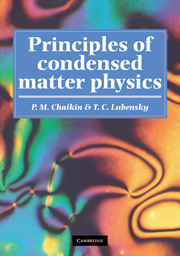Book contents
- Frontmatter
- Contents
- Preface
- 1 Overview
- 2 Structure and scattering
- 3 Thermodynamics and statistical mechanics
- 4 Mean-field theory
- 5 Field theories, critical phenomena, and the renormalization group
- 6 Generalized elasticity
- 7 Dynamics: correlation and response
- 8 Hydrodynamics
- 9 Topological defects
- 10 Walls, kinks and solitons
- Glossary
- Index
2 - Structure and scattering
Published online by Cambridge University Press: 05 June 2012
- Frontmatter
- Contents
- Preface
- 1 Overview
- 2 Structure and scattering
- 3 Thermodynamics and statistical mechanics
- 4 Mean-field theory
- 5 Field theories, critical phenomena, and the renormalization group
- 6 Generalized elasticity
- 7 Dynamics: correlation and response
- 8 Hydrodynamics
- 9 Topological defects
- 10 Walls, kinks and solitons
- Glossary
- Index
Summary
Large collections of particles can condense into an almost limitless variety of equilibrium and nonequilibrium structures. These structures can be characterized by the average positions of the particles and by the interparticle spatial correlations. Periodic solids, with their regular arrangements of particles, are more ordered and have lower symmetry than fluids with their random arrangements of particles in thermal motion. There are a number of equilibrium thermodynamic phases that have higher symmetry than periodic solids but lower symmetry than fluids. Typically interacting particles at low density and/or high temperature form a gaseous phase characterized by minimal interparticle correlations. As temperature is lowered or density increased, a liquid with strong local correlations but with the same symmetries as a gas can form. Upon further cooling, various lower-symmetry phases may form. At the lowest temperatures, the equilibrium phase of most systems of particles is a highly ordered low-symmetry crystalline solid. Nonequilibrium structures such as aggregates can have unusual symmetries not found in equilibrium structures.
In this chapter, we will investigate some of the prevalent structures found in nature and develop a language to describe their order and symmetry. We will also study how these structures can be probed with current experimental methods. Though tools such as scanning force and tunneling microscopes can now provide direct images of charge and particle density, at least near surfaces, most information about bulk structure, especially at the angstrom scale, is obtained via scattering of neutrons, electrons, or photons.
Information
- Type
- Chapter
- Information
- Principles of Condensed Matter Physics , pp. 29 - 107Publisher: Cambridge University PressPrint publication year: 1995
